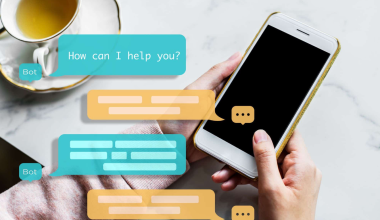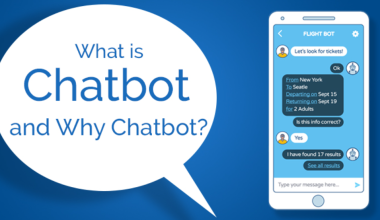Businesses are faced with a critical choice with their customer service: chatbots or live chat? In this blog, we delve into the key differences between chatbots and live chat, helping you make informed choices based on their specific needs with examples. This decision is far from one-size-fits-all!
But first, let’s understand the basics about both of them.
What is Chatbot?
A chatbot is a computer program designed to engage with users through text-based or spoken language, emulating human conversation. Chatbots leverage artificial intelligence (AI) and natural language processing (NLP) to comprehend and respond to customer queries.

These software-based assistants can be integrated into websites, messaging apps, or other digital platforms to provide automated support, engage customers, and offer information.
Here are some of the key benefits of chatbots include:
- 24/7 Availability: Chatbots offer round-the-clock support, being accessible at any time, ensuring assistance for customers across different time zones or business hours.
- Scalability: They can efficiently handle high volumes of customer interactions simultaneously, adapting to increased demand without the need for hiring and training additional support agents.
- Consistency: They can provide consistent responses, ensuring that every customer receives the same information and assistance, resulting in a standardized support experience.
- Efficiency: Chatbots process and respond to customer queries quickly, reducing response times and enhancing the overall customer support experience.
- Data Gathering: Chatbots can collect and store valuable data from customer interactions, allowing businesses to gain insights into customer behaviour and needs, and enabling data-driven decisions for product or service enhancements.
We created a complete guide on Chatbots to help you understand them better.
What is Live Chat?
Live chat is a real-time communication tool that facilitates immediate interactions between businesses and customers through text-based dialogue. This communication method typically involves human agents, such as sales assistants or support teams, who are trained to efficiently address a wide range of inquiries and issues.

Live chat is often embedded across various digital platforms, including websites and social media, through the use of a chat widget.
Here are some of the key benefits of Live Chat include:
- Personalized Assistance: Live chat offers personalized support by allowing customer support agents to address users by their names, and provide tailored solutions based on individual needs. This personalization strengthens the customer-business relationship!
- Real-Time Problem Resolution: A human agent can provide immediate help for customer inquiries leading to real-time problem resolution. This is particularly valuable for urgent matters.
- Detailed Information Exchange: Live chat allows the exchange of detailed information, including screenshots, files, and links. This makes it an ideal channel for troubleshooting technical or complex issues.
8 Key Differences between Chatbot vs Live Chat
Here are the main key differences between chatbot and live chat:
| Factor | CHATBOT | LIVE CHAT |
| Response Time | Quick Responses | Slower Responses |
| Customer Experience | Lack human emotions | Personalized expierence |
| Availability | Available 24/7 without Breaks | Agents Require Breaks |
| Personalized Approach | Limited Personalization | Connects Personally with Customers |
| Implementation | Requires Technical Expertise | Easy to Implement |
| Cost | Cost-Effective for Smaller Businesses | Expensive initially but affordable for large businesses |
| Messaging Channels | Usually limited to one channel | Agents can work on multiple channels |
| Analytics | Can Use More Data Points to Report | Difficult to Analyze and get insights |
1) Response Time
Chatbots: Chatbots are known for their lightning-fast responses. They provide immediate replies to customer queries, reducing wait times to virtually zero. As we know, customers generally find waiting for a reply to be the most frustrating aspect of seeking help from a company.
Live Chat: Live chat response times vary, and they should ideally be less than 3 minutes, with the global live chat average response time being around 1 minute and 3 seconds. While live chat can be relatively fast, it may not match the instantaneous response provided by the competitor.
2) Customer Experience
Chatbots: While chatbots are speedy, they may lack the ability to replicate human emotions. Customer experience involves more than just response time, and many customers feel that nothing can replace the experience of interacting with a real person.
Live Chat: Live chat, with human agents, can offer a more empathetic and human interaction. Building a personal connection with customers and understanding their unique needs is where live chat excels.
3) Availability
Chatbots: They operate 24/7 without the need for breaks or rest. They tirelessly attend to customer queries at all hours, making them ideal for businesses aiming to provide continuous and global support.
Live Chat: While 24/7 live chat support is possible, it comes with logistical challenges such as scheduling human agents to work round-the-clock. Live chat agents may require breaks, and the availability may be limited.
4) Personalized Approach
Chatbots: They offer a limited level of personalization, struggling with emotional nuances and unique customer needs. They rely on pre-programmed responses and AI algorithms, which may not fully understand the subtleties of human interaction.
Live Chat: It is capable of providing a highly personalized approach. Live chat agents can build rapport with customers, connect with them on a personal level, and understand their unique requirements. Some live chat solutions even provide customer info panels with browsing and order history for more effective assistance.
5) Ease of Implementation
Chatbots: Implementing chatbots is becoming more accessible, with many platforms offering pre-made chatbot templates that can be activated with a few clicks. However, designing a custom chatbot may require some planning and effort.
Live Chat: Live chat is relatively easy to integrate into websites and platforms. Many live chat vendors offer user-friendly setups, making it accessible even for non-tech-savvy individuals.
6) Potential Costs
Chatbots: They can be cost-effective, particularly when handling a high volume of repetitive requests. Top chatbot platforms are often subscription-based, and they don’t require as much maintenance since the bots are not hosted on your website. However, extensive customization may increase costs.
Live Chat: It involves recurring expenses, including agent salaries, training, and the cost of the live chat software itself. It may be less cost-effective, especially for businesses on a tight budget.
7) Messaging Channels
Chatbots: Some chatbot platforms are designed for specific messaging channels. For instance, a Facebook-oriented chatbot may excel on Facebook Messenger but may have limitations on other platforms. Businesses need to consider their target audience’s preferred communication channels when choosing a chatbot.
Live Chat: Live chat is more versatile in this regard. It can support multiple messaging channels, providing a consistent level of customer service across the web, mobile apps, and social media. Operators don’t need to worry about the technical restrictions of each channel, as they can manage all messages in one panel.
8) Analytics and Reporting
Chatbots: They provide advanced reporting options, allowing businesses to track and analyze user interactions comprehensively. The data is more straightforward and less influenced by unpredictable factors.
Live Chat: Live reporting is based on human conversations, and while it provides valuable insights into the performance of individual chat operators, it may not offer as comprehensive or straightforward data as chatbots.
Overall, both options have their strengths and weaknesses, and in some cases, a combination of both may be the ideal solution to provide a comprehensive customer support experience.
Which is Right for Your Company?
Choosing between chatbots and live chat depends on your company’s specific needs and customer demographics. Here’s a discussion on which option may be right for different types of companies or scenarios:
You Need 24/7 Support: Chatbots
If your customers require instant responses around the clock, chatbots are an excellent choice. They can provide continuous support without the need for human agents to work at all hours.
High Volume of Repetitive Queries: Chatbots
They excel at handling repetitive queries and providing quick answers. If your business deals with a large number of routine inquiries, chatbots can save time and resources.
You Need Data-Driven Insights: Chatbots
They offer advanced analytics and reporting, making it easier to track user interactions and gather data for analysis. This data can be invaluable for optimizing your customer support.
You Require a Personal Connection: Live Chat
Live chat provides a personal touch that some customers value. The ability to speak with a knowledgeable support agent in real time can lead to more personalized and empathetic interactions.
You Deal with Complex Inquiries: Live Chat
For complex inquiries that demand detailed explanations or emotional nuances, live chat agents are better equipped to handle them. They can adapt to the conversation’s tone, offer reassurance, and think creatively.
You Prioritize Customer Loyalty: Live Chat
Building long-term and loyal customer relationships may be a top priority for your business. Live chat agents can provide empathy and a human touch that can foster customer loyalty.
However, in many cases, a combination of both may be the most effective approach. You can use chatbots for quick responses to common questions and employ live chat for more complex inquiries and offering a human touch.
Ultimately, the decision should align with your company’s customer service strategy and the preferences of your target audience.
By the way, there are forms that some companies still use as a cheaper option. However, we found that Chatbots are far better than Forms.
Some Examples of Different Industries
Let’s explore some examples of how different types of companies can use both of them:
- E-commerce: E-commerce companies often deal with a high volume of customer inquiries related to product availability, order status, and shipping information. Chatbots can efficiently handle these routine tasks, providing quick and accurate responses. Live chat can be valuable when customers have specific questions about product features, comparisons, or personalised recommendations.
- Software as a Service (SaaS) Companies: SaaS companies can use chatbots for onboarding new users, offering self-service tutorials, and addressing frequently asked questions about software functionality. But when the customers encounter complex technical problems, live agents can engage in in-depth troubleshooting, guide users through software configuration, and provide personalized solutions.
- Financial Institutions: Financial institutions can employ bots for basic account inquiries, balance checks, and transaction history. But when customers need assistance with complex financial matters, live chat agents with financial expertise are vital. They can provide personalized financial guidance and address sensitive financial issues.
- Travel and Hospitality Industry: Bots can assist travellers with booking confirmations, flight information, and general travel inquiries. They can also help with automated check-ins and provide recommendations for restaurants and activities. In situations where travellers encounter issues with reservations and require assistance in unfamiliar destinations, live chat agents can offer immediate support.
- Food Delivery Services: Food delivery services can use chatbots for order placement, tracking, and general menu inquiries. In cases where customers encounter issues with their food orders, have special dietary requirements, or need assistance with delivery instructions, live chat agents can offer personalized support and resolve order-related concerns.
Overall, chatbots have use cases in almost all industries, where you can use it alone, or combine it with your human customer care team.
Takeaways
The choice between them isn’t a binary decision; it’s a strategic consideration that should align with your company’s unique needs and the preferences of your customer base. Now you know the main differences in this guide for Chatbots vs Live Chat. By understanding the strengths of each option and the scenarios they best suit, it will be easy to decide






